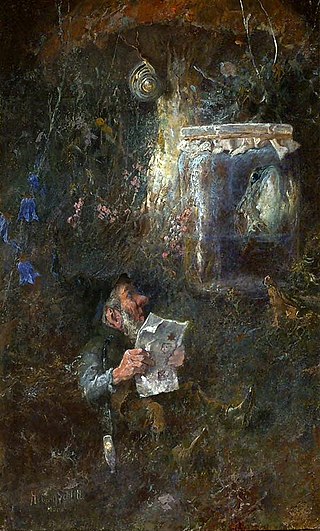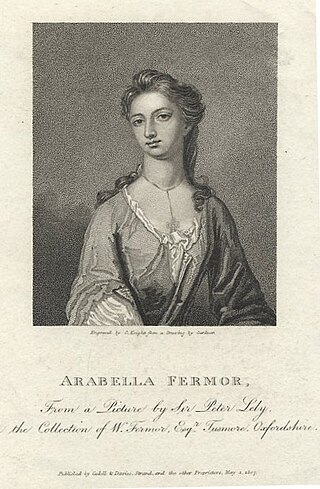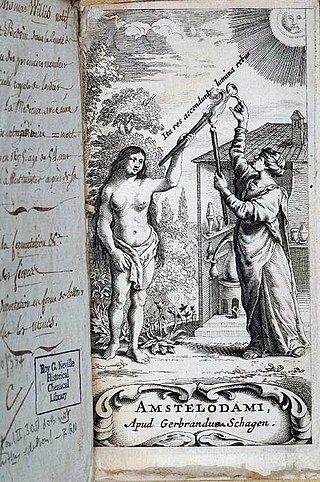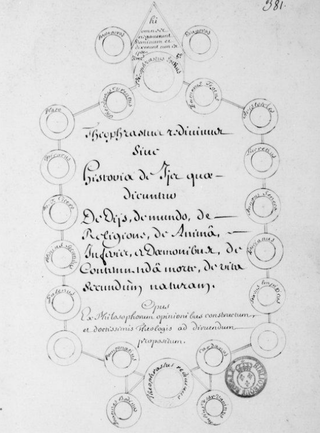
A gnome is a mythological creature and diminutive spirit in Renaissance magic and alchemy, introduced by Paracelsus in the 16th century and widely adopted by authors including those of modern fantasy literature. Typically small humanoids who live underground, gnome characteristics are reinterpreted to suit various storytellers and artists.

Paracelsus, born Theophrastus von Hohenheim, was a Swiss physician, alchemist, lay theologian, and philosopher of the German Renaissance.

An elemental is a mythic supernatural being that is described in occult and alchemical works from around the time of the European Renaissance, and particularly elaborated in the 16th century works of Paracelsus. According to Paracelsus and his subsequent followers, there are four categories of elementals, which are gnomes, undines, sylphs, and salamanders. These correspond to the four Empedoclean elements of antiquity: earth, water, air, and fire, respectively. Terms employed for beings associated with alchemical elements vary by source and gloss.

The Rape of the Lock is a mock-heroic narrative poem written by Alexander Pope. One of the most commonly cited examples of high burlesque, it was first published anonymously in Lintot's Miscellaneous Poems and Translations in two cantos ; a revised edition "Written by Mr. Pope" followed in March 1714 as a five-canto version accompanied by six engravings. Pope boasted that this sold more than three thousand copies in its first four days. The final form of the poem appeared in 1717 with the addition of Clarissa's speech on good humour. The poem was much translated and contributed to the growing popularity of mock-heroic in Europe.

In Renaissance alchemy, alkahest was the theorized "universal solvent". It was supposed to be capable of dissolving any composite substance, including gold, without altering or destroying its fundamental components. By extracting from composite substances their fundamental virtues and properties, alchemists hoped to gain control of invaluable medical healing properties. For this reason the alkahest was earnestly sought. At the same time, its very existence was debated among alchemists and philosophers.
A sylph is an air spirit stemming from the 16th-century works of Paracelsus, who describes sylphs as (invisible) beings of the air, his elementals of air. A significant number of subsequent literary and occult works have been inspired by Paracelsus's concept: Robert Alfred Vaughan noted that "the wild but poetical fantasies" of Paracelsus had probably exercised a larger influence over his age and the subsequent one than is generally supposed, particularly on the Rosicrucians, but that through the 18th century they had become reduced to "machinery for the playwright" and "opera figurantes with wings of gauze and spangles".

Undine is a fairytale novella by Friedrich de la Motte Fouqué in which Undine, a water spirit, marries a knight named Huldbrand in order to gain a soul. Published in 1811, it is an early German romance, which has been translated into English and other languages.
A sprite is a supernatural entity in European mythology. They are often depicted as fairy-like creatures or as an ethereal entity.

Undines are a category of elemental beings associated with water, stemming from the alchemical writings of Paracelsus. Later writers developed the undine into a water nymph in its own right, and it continues to live in modern literature and art through such adaptations as Danish Hans Christian Andersen's 1837 "The Little Mermaid" and the 1811 novella Undine by Friedrich de la Motte Fouqué.

Iatrochemistry is an archaic pre-scientific school of thought that was supplanted by modern chemistry and medicine. Having its roots in alchemy, iatrochemistry sought to provide chemical solutions to diseases and medical ailments.
The Golden Pot: A Modern Fairy Tale is a novella by E. T. A. Hoffmann, first published in 1814 and revised by the author in 1819. Hoffmann regarded it as his best story, and there is wide agreement among literary scholars that it is a masterpiece of romantic literature.
The salamander is an amphibian of the order Urodela which, as with many real creatures, often has been ascribed fantastic and sometimes occult qualities by pre-modern authors not possessed by the real organism. The legendary salamander is often depicted as a typical salamander in shape with a lizard-like form, but is usually ascribed an affinity with fire, sometimes specifically elemental fire.

Renaissance magic was a resurgence in Hermeticism and Neo-Platonic varieties of the magical arts which arose along with Renaissance humanism in the 15th and 16th centuries CE. During the Renaissance period, magic and occult practices underwent significant changes that reflected shifts in cultural, intellectual, and religious perspectives. C. S. Lewis, in his work on English literature, highlighted the transformation in how magic was perceived and portrayed. In medieval stories, magic had a fantastical and fairy-like quality, while in the Renaissance, it became more complex and tied to the idea of hidden knowledge that could be explored through books and rituals. This change is evident in the works of authors like Spenser, Marlowe, Chapman, and Shakespeare, who treated magic as a serious and potentially dangerous pursuit.
Comte de Gabalis is a 17th-century French text by Abbé Nicolas-Pierre-Henri de Montfaucon de Villars (1635–1673). The titular "Comte de Gabalis" is an esotericist who explains the mysteries of the world to the author. It first appeared in Paris in 1670, anonymously, though the identity of the author came to be known. The original title as published by Claude Barbin was Le comte de Gabalis, ou entretiens sur les sciences secrètes, "The Count of Cabala, Or Dialogs on the Secret Sciences".

Theophrastus redivivus is an anonymous Latin-language book published on an unknown date sometime between 1600 and 1700. The book has been described as "a compendium of old arguments against religion and belief in God" and "an anthology of free thought."

Fabrizio De Rossi Re is an Italian composer and librettist. He composes operas, symphonic, choral and chamber music, and performs as a pianist.

At the Sign of the Reine Pédauque is a historical novel by Anatole France, written in 1892 and published the next year. The novel tells of the tribulations of the young Jacques Ménétrier at the beginning of the 18th century. Its most important source is the 17th-century occult text Comte de Gabalis.
Solomon or Salomon Trismosin was a legendary Renaissance alchemist, claimed possessor of the philosopher's stone and teacher of Paracelsus. He is best known as the author of the alchemical works Splendor Solis and Aureum Vellus.
Nicolas-Pierre-Henri de Montfaucon de Villars, the abbot of Villars, also known as Henri de Montfaucon de Villars, was a French abbot and writer in the 17th century.

A spirit —in the sense in which the word is used in folklore and ethnography— is an "immaterial being", a "supernatural agent", the "soul of a deceased person", an "invisible entity" or the "soul of a seriously suffering person.













